![]()
![]()
![]()
Use LEFT and RIGHT arrow keys to navigate between flashcards;
Use UP and DOWN arrow keys to flip the card;
H to show hint;
A reads text to speech;
77 Cards in this Set
- Front
- Back
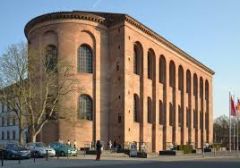
Aula Palatina Germany Late Antique Europe Early 4th century C.E. _____________________ Content: Built in the traditional Basilica plan, this was a christian church created more for the purpose of service rather than a display of grander. _____________________ Style: Almost all styling of the church is on the interior, besides the arched windows and apse which can all be viewed from the exterior all well. The overall style of the church is similar to Roman architecture but with early christian influences. The are still the repetitive roman arches around the windows, the high ceiling, and the main meeting space that became a space for the pews. But this church had a very different purpose than the basilicas and temples of ancient Rome; instead, the Aula Palatina was open to the entire public, represented the change in religious beliefs from Roman mythology to christianity. The interior is also very stark and bare, with the inclusion of small panes of glass in the barred windows. The apse also includes a high, domed ceiling with coffers, similar to the Pantheon, but in this case made with wood. |
Context: This church was built during the very final days of the Roman Empire and the beginning of the rise of Christianity and the Dark Ages. The overlaps in eras explain the roman influences that appear, but also why those influences are more simplified. The church was focused less on decoration and appearance than it was on just supplying a place for christian worship, which is why the interior is stark and bare, with all focus centered on the altar and where the service would have taken place. |
|

Old St. Peter's Basilica Rome, Italy Late Antique Europe Early 4th century C.E. _____________________ Content: This is a building built in the Vatican in Rome, which consists of a main basilica, side aisles, a courtyard, and a surrounding wall. _____________________ Style: The basilica here was built as a variation of the traditional basilica plan, one that disappears until later christian architecture. It involves a main basilica area, with side aisles built off on either side to expand the interior space. The basilica space ended with an apse and was then bisected by a horizontal hallway called the transept, to make the entire building a representation of the cross. The building was also surrounded by a gate, with a narthex entryway leading to an atrium (not unlike the private homes of Roman times). Also like the Romans, the basilica included colonnades and a clerestory. |
Context: The building reflects some of the influences that no doubt came from the city of Rome that surrounded the Vatican, including the atrium with a water-based center (fountain) and the colonnades. This basilica is now referred to as the "old" St. Peter's Basilica because, during the start of the dark ages, it fell into disrepair. People raided the building for construction materials to build their own houses. The basilica was also made from stone, concrete, and had a wooden roof that eventually caught fire and added to the destruction. A new St. Peter's Basilica was built later on in the exact place where this one once stood and the newer version still stands today as part of the Vatican. |
|
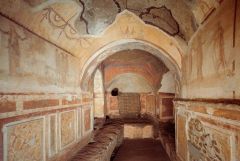
#48 Catacombs of Priscilla Rome, Italy Late Antique Europe _____________________ Content: These catacombs are underground tunnels carved from tufa stone that lay beneath a villa and house (or used to house) around 40,000 tombs for early Christians in Rome. There are stacked shelves throughout the tunnels where the bodies were places and some parts of the catacombs are decorated with frescos. The entirely of the tunnels are about 5 miles in length. _____________________ Style: The tunnels were all carved by hand as were the "liccoli", the spaces for the bodies. The painted frescos, especially those in the entryway to the tunnels, included the 1st, 2nd, 3rd, and 4th orders of painting, with panels decorated with painted stone borders and with illusionistic sense within the panels. The liccoli themselves were also hand-carved, sealed with plaster, marble, or terra cotta and then painted. |
Context: Early Christians at this time were largely prosecuted in the Roman Empire, which is part of the reason why these burial sites had to be constructed underground and out of plain sight. Still, the decorations of the catacombs are very Roman, with the use of the order of fresco paintings and use of construction materials like plaster, marble, and terra cotta, as well as the similar painting materials. At the same time, though, these tunnels held the strongly unique and identifiable iconography, symbolism, and stories of Christianity. The land under which the catacombs were constructed was actually gifted by a wealthy, christian (although perhaps not openly) patron named Priscilla who was herself, buried within the catacombs. Her house rests onto of the complex and the basement of the house serves as the main entry point to the tunnels. The bodies stored in the tombs of the catacombs were mostly people of the Christian faith who had died for the name of their religion and were hence religious martyrs and saints, with their bodies being considered relics, that could be worshiped by living Christians in the catacombs. |
|
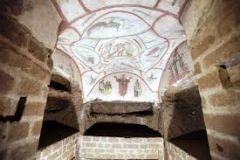
#48 Greek Chapel In Catacombs of Priscilla _____________________ Content: This is a section of the catacombs called a cubicula that is painted with significant frescos depicting certain stories from both the new and old testaments of the Bible. The scenes include the story of the salvation of Susanna by Daniel, the resurrection of Lazarus, and the story of Moses striking water from a rock. There is also the inclusion of animal imagery (peacocks, doves, quails, and sheep) and the Orant and Good Shepard frescos. There is even a fresco that looks very similar to a representation of the last supper. All the frescos are focused in depicting the various miracles of christ. _____________________ Style: The style of fresco shown here is known as the Pompeian style, utilizing green and red lines to separate different stories and imitating the look of marble. The background of the frescos are also painted white, possibly to enhance the image or to create a feeling of salvation. Additionally, each of the figures are simplified and have slightly unrealistic proportions. |
Context: This section was dubbed the "Greek" chapel because some greek symbols were found right along side the Christian symbols (like images of anchors and fish) and some latin writing. It is part of the catacombs that is closest to the basement of the house, meaning it was one of the first cubicula to be carved and decorated. Other than depicting the miracles of Jesus, the Greek Chapel also has a fresco dedicated to the life of Priscilla and it is thought that her body may have been placed here, along with those of her family, as a tribute for her patronage and christian faith. The painted peacocks, too, symbolize the afterlife. |
|
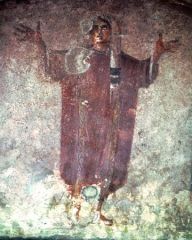
#48 Orant Fresco In Greek Chapel _____________________ Content: Thought to be a depiction of Priscilla herself, the orant fresco actually contains two other images other than the one of Priscilla in the orant position. The two other images show Priscilla getting married and then having children. In the center, orant image, Priscilla is looking upwards and holding her hands out as if to receive something. _____________________ Style: There is still a stylization and simplification happening in this fresco, like the lack of personalized features in the face and enlargement of the hands. The colors of the fresco are relatively muted but the inclusion of blue in Priscilla's head wrap is reminiscent of the Virgin Mary. The shading of the face also gives the impression that there is a light source coming from above. |
Context: The panel which displays the orant fresco is thought to be depicting the major life events of Priscilla, including her marriage, child bearing, and, in the orant fresco, her death and assent into heave. Because the artist utlized the orant pose, and positioned Priscilla's eyes to be looking above, it is represented that she is looking up to and receiving her salvation in heaven. The use of shading and implying a light source also speaks to the idea that Priscilla is ascending into the light of heaven. The use of all this imagery was probably used to inspire the Christian faith to all practicing Christians who came to the catacombs seeking refuge to practice their religion or worship the remains of christian martyrs who had died for their faith, which may have included Priscilla. |
|
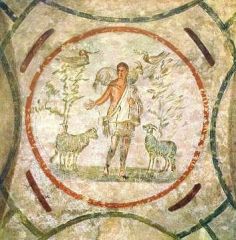
#48 Good Shepard Fresco In Greek Chapel _____________________ Content: This fresco shows a young man standing, surrounded with sheep, birds, and two trees. The fresco is encircled by Pompeian borders and is in the center of the ceiling in the Greek Chapel. _____________________ Style: The young man is in the classical roman contrapposto pose, with shifted weight and a tribute to naturalism, despite the figures iconic and stylized look. |
Context: The fresco was meant to display a young jesus in the literal position of being a good Shepard to his flock. The image shows christ as young, perhaps also innocent, healthy, and strong. The sheep represented the christian worshipers and how they would be protected by Jesus. It was another fresco done to help inspire faith in the early christians and continuously remind them of the stories and beliefs of the Christian faith. |
|
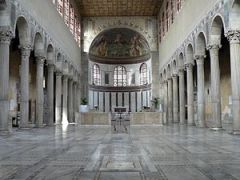
#49 Santa Sabina Rome, Italy Late Antique Europe 422 - 432 C.E. _____________________ Content: This is a basilica plan christian church, very similar to the Aula Palatina but with side aisles and more decoration. _____________________ Style: Although this church is similar to the Aula Palatina, it's interior architectural innovation and decoration is more elaborate and harkens back to the glory of Rome and the Old St. Peter's Basilica decoration with the use of colonnades, roman arches and side aisles. The church includes Corinthian Columns, a clerestory, and a coffered roof. The doors are original wooden ones with 16 panels each that depict scenes from the Bible. The windows were originally made of selenite - a clear stone that was refined and cut thin.
|
Context: This was an early Christian church built on a section on land donated by a women called Sabina who was executed for practicing the Christian faith and converting to Christianity. Because of her death, she was made a saint for which they named the church after. The elaboration in decoration in this church also speaks the rising power of Christianity in Rome and elsewhere that was expressing pride in its religious values for the public. The paneled doors of the church set a standard for church doors for many years, utilizing the panels to separate and depict stories of the Christian faith. |
|
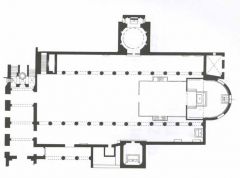
#49 Santa Sabina Rome, Italy Late Antique Eruope 422 - 432 C.E. _____________________ Content: Basilica Plan church with additives built with style in mind. ___________________ Style: The Santa Sabina was an expansion on the traditional Basilica Plan with a nave, expansive side aisles all facing towards the apse. The church also included colonnades and utilized the side aisles to support the clerestory level and heighten the ceiling. The paneled doors were also a new innovation in architectural design. |
Context: The floor plan of the Santa Sabina represented the next step the Christians took in expanding their faith through their churches. |
|
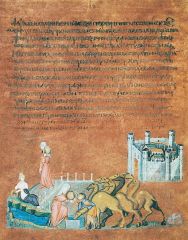
#50 Rebecca and Eliezer at the Well, from the Vienna Genesis Early Byzantine Europe Early 6th Century C.E. ___________________ Content: This singular page depicts the story of a pink clad women leaving a walled city, walking along colonnaded paths to a well, where she provides a drink of water to a young man and his many camels. There is a semi-nude female perched near the well but is not interacted with by any of the other characters. The page also includes written text above the illustration of the story. ___________________ Style: Made on vellum (calf's skin) and illustrated with painted pictures and inked words, the pages of this book represented the early medieval style in art and documentation. The pictures, depicting the story of Rebecca and Eliezer from the Old Testament, was created using continuous narration, with all the events of the story taking place along the same timeline or the same scene (similar to a time-lapse). There is an attempt at illusionary perspective in showing the far-off city from where Rebecca came from, but it lacks reality. The columns, similarly, are too small in their proportions to appear life-like. The entire surface of the vellum was originally soaked in dye to make it purple and the letters were painted using silver leaf. |
Context: This is a single page from the illuminated manuscript called the Vienna Genesis (a version of the Old Testament from the Bible). These types of medieval books (made like those today, with separated pages and hard front and back covers) were created with detailed illustrations to communicate the messages and stories in Christian religion to a largely illiterate population in Europe. However, the costs of producing these early codex pieces of religious value was so expensive that they were created at the commands of royal families and used to educate the royals of Europe in Christianity. This led to the lavish design of some of the manuscripts and the use of silver leaf in the Vienna Genesis. It communicated a connection between the power of religion and the power of royalty. The semi-nude female figure was meant to be the human representation of the well (or the spring around which it was built). This use of personification is similar to the Greek and Roman myths about water spirits and shows the borrowing of ideas between the weakening influences of Rome and Early Christian Europe. |
|

#50 Jacob Wrestling the Angle, from the Vienna Genesis Early Byzantine Europe Early 6th Century C.E. ___________________ Content: This page shows the procession of Jacob and his followers and the confrontation Jacob has with an angel. The story is based off the biblical story and is depicted as one illustration. ___________________ Style: Made in the same style as the first page (Rebecca and Eliezer), this page utilizes the continued narration technique and use very undeveloped forms of perspective. The scene is depicted as moving right to left, then at the edge of the illustration, the bridge is painted with an attempt at changing depth and perspective so that the narration continues on the bottom half from right to left. The figures themselves also have incorrect proportions, with too large of hands and heads to fit the short bodies. |
Context: This page holds the same context as the last, but with specifics on the lack of proportion and coloration of the pages. After the fall of Rome, many of the perfected artistic cannons of proportion, realism, or even expressionism vanished. The illustrations in the Vienna Genesis show a "return" to the art seen before the development of classical pieces and convey the limited knowledge these artists had about being able to create correct proportions or illusionary depth on the 2-D surface. The pages of the book, as mentioned before, were either painted or dyed purple. This was done in order to enhance the royal appearance of the book, as purple was considered a royal color. |
|

#51 San Vitale Ravenna, Italy Early Byzantine Europe 526 - 547 C.E. _____________________ Content: A central plan Christian church with three stories and including the traditional uses of a clerestory and very early versions of flying buttresses. _____________________ Style: Despite the innovative advancements in the building's exterior and interior design, it is still very Italian, with light stone cut walls and a red shingled roof. There is also a constant incorporation of the Roman arch above the windows and throughout the interior. The octagonal, central plan also used a smaller, raised third story to achieve a greater height. |
Context: Ravenna stood, at one time, as the capital of the Western Roman Empire. The city was the only real stronghold in the declining Wester Empire as Rome fell but was taken over by Justinian who had claimed to be the new Roman Emperor and sought to reunite and restore the original Roman Empire (his goal being to make the Mediterranean Sea once again the "Roman Lake"). San Vitale was commissioned in Ravenna by Justinian in attempt to not only restore the glory of Rome through massive, public and religious works, but also to convey Justinian's success in expanding his new Roman empire. |
|
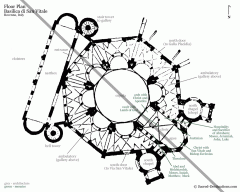
#51 San Vitale Plan Ravenna, Italy Early Byzantine Europe 526 - 547 C.E. _____________________ Content: The San Vitale was built using a central plan, with an octagonal shape. It included a main, center worship area, along with other new additives and architectures advances. Among there were the inclusion of the narthex, cloisters, and an ambulatory. _____________________ Style: By using a central plan instead of a basilica plan, the San Vitale instantly became noticeable among the other early christian churches. The plan shows the raising center that hovered over the central worship area as well as the ambulatory that serves as a walking space around the entire church. The entrance, within the narthex, is similar to that of the Roman Pantheon. Roman columns also separate and support the central nave. There is still a small apse flanked by two circular chapels. Inside the church, pendentives aided the columns in supporting the domed roof of the church. |
Context: The architectural design of the church was both very Byzantine and very Roman. This served the purpose of the Emperor Justinian as he sought to reinvent the classical Roman Empire, but with his own Byzantine influences and whims. The collection of both classical and innovative aspects of the building's style displayed to the public the how traditional yet novel, as possibly better, the rule of Justinian was compared to that of the barbarian rulers of Northern Europe. Since it was a christian church in a time of rising christian popularity, part of the church's design was also concerned with being able to contain a larger number of christian worshippers in the central area, hence the elevated size of the church. |
|
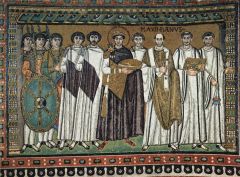
#51 Justinian Panel In San Vitale _____________________ Content: This mosaic, one of the many within the San Vitale, shows Emperor Justinian dressed in dark robes and placed in the center of the piece. He is surrounded by symbolic soldiers and advisors on either side. _____________________ Style: As a mosaic, this art pieces is made of thousands of tesserae (bits of glass, stone, gold, and semi-precious stones). The use of the tesserae allowed the pieces to sparkle and simmer when reflected with light. All the figures pictured in the mosaic are in stoic, frontal-facing positions. The figures lack very defined, individual facial features. They all, however, have the characteristically Byzantine eyes, with heavy, dropping lids. The mosaic is also bordered by Byzantine designs that were all around the interior of the church, in vibrant colors. |
Context: The interior decoration of the San Vitale could be described as a sensory overload, meant to inspire greater faith in its audience or convince them to convert to christianity if they had previously worshipped other religions. The elaborate decoration was also meant to reflect favorable upon Justinian as well, since he had commissioned the church. The use of mosaic as opposed to frescos allowed for more flection of light; at the time, people used oil lamps to light the church as the reflection off the mosaic of the lamps would create an awe-inspiring (or rather, faith-inspiring) sparkle on almost every surface of the church. In the Justinian panel itself, Justinian is intentionally put in a place of importance, signifying his authority as the new Roman Emperor. Justinian is also pictured with elaborate dress and ornamentation, signifying his wealth. The soldiers on either side are symbolic of the fight for Christianity and are flanking Justinian in a way to communicate that the emperor, as well, is ready to fight for the Christian faith. |
|
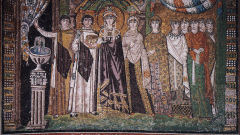
#51 Theodora Panel In San Vitale _____________________ Content: This mosaic is one of Justinian's wife, Theodora. She is shown in fine, dark robes like her husband and with heavy ornamentation and jewelry around her face. There are other attendants and people of importance around her, along with decorative banners and a fountain. _____________________ Style: Again, the mosaic is done with an emphasis on pattern, color, and generalization of figural imagery. |
Context: Theodora was, originally, of no royal blood of all. She was something of an erotic dancer/prostitute when she seduced Justinian and they married, making her an empresses. And, according to his history, she began a strong and steadfast wife and leader of the new Roman Empire with Justinian. Unlike many female characters at the time, she was adored by her husband and given an elevated status at his side, as well as a voice is some political decisions. In fact, when the palace of Justinian was raided by barbarians with the intent of killing the emperor, Theodora was the one who persuaded Justinian to stay and fight rather than flee, salvaging the New Roman Empire and its plans to expand and stay in power. Her power and influence alongside her husband perhaps resulted in her being honored with a panel in the San Vitale beside the one of her husband. The mosaic served the same purpose of that of Justinian, solidifying the emperor's power and connection to the christian religion. Here, Theodora is pictured with a fountain, as it was common to include a source of water in symbolic art pieces. |
|
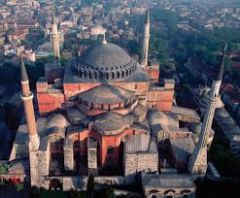
#52 Hagia Sophia Constantinople (Istanbul) Anthemius of Tralles and Isidorus of Miletus 532 - 537 C.E. _____________________ Content: This is a church complex that conveys the influences of Christianity, the Justinian Empire, and Islamic beliefs in its construction and design. _____________________ Style: Externally, the Hagia Sophia is a compilation of early Christian and Islamic elements. The main, block-shaped base of the building was from the original Christian construction while the other, smaller domes and minarets were added later. Symmetrical in its construction, the church has several half domes over apses on either side, as well as roman arches and a clerestory around each dome. The main dome was built on a massive scale and required a large square drum to support it. |
Context: This church was originally built by Justinian as a Christian center in his new Byzantine Empire. It continued to utilize the central plan but had other features that were more distinct to the are, reflecting the assimilation of many cultures under the new Roman Empire. After the decline of Justinian, the church became a Catholic church, then Islamic mosque, and is now a secular historical site. The layering of multiple religious influences result in abstract design of the church, like the Byzantine base architecture, the large scale that was traditional for Catholic churches, and the Islamic interior decorations. The architects and their subsequent professions also explains the structure. Isidorus of Miletus was a physicist with previous building experience, which explains how the construction of the building is so in tune with the laws of physics to allow for the creation of the massive dome. Anthemius of Tralles was a mathematician and contributed mathematic precision and accuracy in the building of the church. The combination of the designer's two talents was probably the reason the Hagia Sophia was able to achieve a larger scale in its construction. |
|

#52 Hagia Sophia (Interior) Constantinople (Istanbul) Anthemius of Tralles and Isidorus of Miletus 532 - 537 C.E. _____________________ Content: The interior of the Hagia Sophia consists of both Christian religious imagery, conveyed through frescos and mosaics, as well as Islamic, calligraphic writing used as decoration. _____________________ Style: Overall the decoration is very lavish, with amber and black themes. Among the frescos and mosaics are columns with 8ft tall vessels that were appropriated from ancient Greek and Roman sculpture and ceramic work. The Colonnades have Christian/Byzantine capitals with larger pendentives to support the dome while still allowing the interior space to flow and remain aesthetically pleasing. The church also has many side niches with frescos of both Byzantine and Roman symbols. Most of the mosaics were made with gold and glass tessera that allowed for the continued use of sparkle and light. The Islamic influence of the Sultans and Ottoman Empire (the crushed that of Justinian) can been seen through the many Islamic symbols, writing, and water foundations or sources that were installed. |
Context: Once again, the interior decoration of the Hagia Sophia is reflective of the many cultures and religions that thrived within the church at different times. The frescos, being a hold-over from the influences of Rome; the mosaics being a very Byzantine design, and the calligraphic writing being that of the Islamic culture. |
|
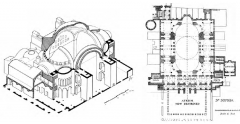
#52 Hagia Sophia Plan " " _____________________ Content: The main aspects of the floor plan are the central dome, where the nave rests, the half domes and the apse at the end opposite of the entrance, the surrounding aisles, and the narthex that houses the entrance. _____________________ Style: The church was built around the Byzantine central plan (with narthex) and included the traditional christian addition of an apse. The domed roofs were a more Islamic (but still derived from Roman) influence. |
Context: Since the church was passed through many different ownerships and religious purposes, it's construction spanned a certain time period. This meant the church was being constantly added onto whenever it transferred between empires. The central plan, for example, and the blockish appearance of the church was an original part of the Christian construction. But later, in the Ottoman Empire, the minarets were added as part of the Muslim practice of calling to prayer. In this way, the Hagia Sophia developed into the expanded complex that exists today. |
|
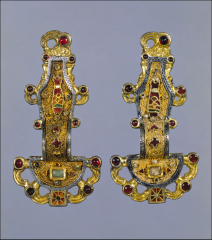
#53 Merovingian looped fibula Early Medieval Europe Mid-sixth Century C.E. _____________________ Content: These are two matching pieces that were created as a pair. They are mostly hammered gold, with designs and inlayed semi-precious stones, like garnet. _____________________ Style: The designs, being hammered and etched into the gold surface, are elaborate and intertwining, similar to celtic knots. The fibula themselves also display zoomorphic motifs, being in the shape of an eagle (with the beak at the top and a garnet serving as the eye). There is also a fish design in the center of each piece. The animals representations are very stylized, with more emphasis on intertwining design that accurate details. |
Context: On the larger historical scale, these fibula were created at the brink of the fall of Rome and the onset of the Dark ages. At this time, society was loose and disorganized and there was no public movement to create large, central works of art for cities or empires (like there had been in Rome). Instead, there was a focus on the creation of small, personal artifacts that could symbolize social standing and be buried with an individual at their death. The fibula themselves were used as clasps wore at the shoulder (one on either side) in order to hold up the robes wore at the time. Their decoration served as a status symbol, the more elaborate decoration serving to communicate a higher societal and economic standing. For example, in the Justinian Panel in San Vitale, the emperor is pictured much more decorative clasps/fibula on his robes than those around him, signifying his elevated status. Interestingly enough, the actual idea behind the clasps harkened back to those created by the Etruscans and classical Romans. The zoomorphic imagery and emphasis on pattern and design represents a shift at that time in history that took artistic subject away from figural representation and back to that of traditional subjects - animals and patterns. There was no longer an interest in depicting the perfect human form. Instead, animals once again became important symbols in human society, especially for the traditional Celts and Vikings. |
|
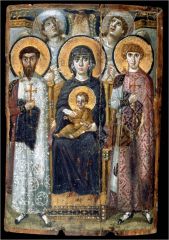
#54 Virgin (Theotokos) and Child between Saints Theodore and George Early Byzantine Europe 6th or early 7th century C.E. _____________________ Content: This shows the virgin Mary resting in a large, almost throne-like chair, while holding the infant Jesus on her lap. She is flanked by two solider saints with two angels in the background looking up. All the figures have strong halos painted around them, with the center character's being gold and the angel's halos being silver. _____________________ Style: The style of this painting is very Byzantine, with drooped eye lids, no figural shape, and seemingly floating feet. The entire piece is actually a encaustic art form, meaning it was painted used wax to retain color. The halos of the frontal characters are painted with shimmery gold to create contrast. There is an apparent light source that comes from above which allows for shadows to be painting under the saints and the chair to create some form of depth in the compact area. The figures, while still very stylized and iconic, show some return to realistic elements. The turn of the angel's necks for example, uses shading and shadow to illustrate the shape of their collarbones. The Virgin Mary's lap too, shows a definition figure with the easy identification of her knees underneath the fabric of her gown. The figures eyes are also used to create symbolic movement in the piece. The saint (and Jesus) stare out straight ahead, but without any real recognition of an audience in order to maintain an iconic appearance. The virgin Mary, on the other hand, is looking off and away from the audience. And finally, the angels in the back are looking upwards to a figurative representation of God in Heaven. |
Context: Besides being one of the first intentionally created piece featuring the Virgin Mary with the infant Jesus, the Theotokos piece also contains the history of the early expansion of Christianity. Because the early Christian and Byzantine empire started up in mainly Greek-speaking communities, the expansion of the empire expanded primarily around the Mediterranean sea, into Egypt (where the Theotokos piece was painted). The Byzantine people, in their expansion, were also keenly interested in created valued, artistic representations of the scenes from the Gospels and Old Testament, resulting in the rise of the iconic painting of religious subjects. By using the iconic styles, the images were able to educate and inspire the Christian faith. |
|
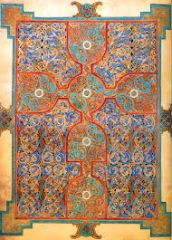
#55 Lindisfarne Gospels Cross carpet Page Early Medieval Europe (Hiberno Saxon) 700 C.E. _____________________ Content: This is the carpet page of St. Matthew, designed with incredible detail, sophisticated pattern and color. Among the designs there are outlined borders as well as the prominent shape of a cross in the center of the piece. _____________________ Style: Most of the design of this piece is made from repeating knotted shapes, spirals, and other intricate patterns that all together form the "carpeted" aspect of the piece, as well as the cross in the center. Upon closer inspection, it can be seen that most of the knotted designs are composed of tiny, intersecting snakes in bright sapphire, verdigris, and gold. The cross shape, made of stacked "wine glass" shapes, is outlined in red to bring it into focus. |
Context: The entirety of the Lindisfarne Gospels are inked into a codex created by a monk named Eadfrith who resided on the island Lindisfarne off the English coast. Eadfrith, thought to be working from an Italian copy of the Gospels from Italy (the gospels at that time were extremely rare and valuable), created the multi-leafed codex with his own, unique illustrations within the writings of the gospels themselves. The codex was created on vellum which can been seen, in some places, as vacant or abstract space. The gospels were dedicated to a St. Cuthbert, who was thought to preform miracles throughout his lifetime and who inspired the Cult of St. Cuthbert in which Eadfrith was involved in. |
|

#55 Lindisfarne Gospels St. Luke incipit page Early Medieval Europe (Hiberno Saxon) 700 C.E. _____________________ Content: This page, adjacent to the carpet page of St. Luke, commemorated and communicated the first line of St. Luke's gospel (in Latin) with intricate decorations around the first, enlarged letter "q" and around the rest of the words as well. _____________________ Style: There are yet more spirals and patterns in this illustration, along with more animal imagery. The letter "q" is expanded to take up at least half of the page and is independently decorated with blue pinwheels spiraling to make a vortex space. There are also more knotted snakes along with birds and a feline. In the rest of the sentence, words were either inked out in little, red dots or inked around so that the negative space formed the letter itself. |
Context: Having the same historical context as the previous page and the rest of the codex, the St. Luke incipit page is only different in the fact that it shows how the gospels were written. The sentences themselves are so elaborately decorated that it really shows how much value was put into these rare copies of the disciple's accounts of Jesus's life. The Lindisfarne Gospels show the importance and expansion of Christianity, even in the northern areas of Europe. |
|

#55 Lidisfarne Gospels St. Luke portrait page Early Medieval Europe (Hiberno Saxon) 700 C.E. _____________________ Content: This portrait piece of St. Luke is a more straightforward than the carpet or incipit pages. This page shows St. Luke sitting on a stood, with a foot rest, posed to start writing on a scroll. He is pictured with a large halo around his head and there is also a flying calf behind him holding a parallelogram shape that was meant to represent the codex of the gospels. _____________________ Style: More simplistic and iconic, this portrait shown St. Luke in the colorful robes of a scholar, with generic features and noticeable halo that is painted brightly to represent divinity. The illustration is also bordered and has written symbols around the figure of St. Luke. |
Context: The most interesting historical context of this piece is centered around the flying calf. Some historians think that the calf could be representative of Christ's sacrifice on the cross. Another possibility is that the flying calf was a pagan symbol that was incorporated into the text because, at the time, the messages of the gospels were seeking to expand into areas populated by paganism. Apparently, it helped incorporate pagans into the christian faith when they could identify familiar images in religious works. |
|

#56 Great Mosque Cordoba, Spain Umayyad 785 - 786 C.E. _____________________ Content: This is an Islamic Mosque that was built around a Catholic church. It's a full complex with a qibla wall, three stories, clerestory, courtyard, flying buttresses, and an interior hypostyle hall. _____________________ Style: This building was styled in the act of appropriating a Catholic into the Islamic culture, which is why the gothic flying buttresses existed right along side the hypostyle worship hall. The Islamic influence also the construction of the south-facing entrance within the qibla wall, which was also the direction that went towards Mecca. There are also various Islamic appropriations of the Roman arch but put into a "key-hole" shape and usually used for doorways. And, as typical for Islamic decoration, there is an emphasis on pattern, geometrical shapes, repetition, and mathematical precision rather than figural representation. There is also more Islamic calligraphic writing as decoration. The hypo style hall itself is supported by many many columns with doubled roman arches that are decorated with stripes (called the "candy cane" decoration). |
Context: Most of the historical context of this piece has to do with the Ottoman expansion over Christian/Catholic territory and transition to the Muslim faith. The decorations throughout the building are representative of the Islamic tradition of utilizing mathematical patterns instead of figural, religious figures within the mosque. The hypo style hall takes up most of the mosque and served as a worship area large enough for enough people to worship there at certain times of the day. |
|
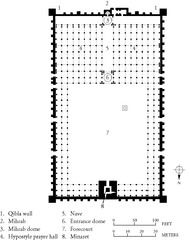
#56 Great Mosque floor plan Cordoba, Spain Umayyad 785 - 786 C.E. _____________________ Content: The floor pan pictured here conveys the shape of the Great Mosque, its detailed hypostyle hall filled in columns, the empty courtyard, the surrounding walls, and entryways. ___________________ Style: The hall, as it can be seen, stretches around the inner (original) catholic church and around the courtyard. The columns inside were used for support but also decorated with the "candy cane" design. The qibula wall extends all the way around the complex, leading to the main entrance at the Mihrab. |
Context: The Great Mosque and its stylized construction now stands as a tribute to the times when Islamic forces ruled over most of Spain and Portugal. In in the Mosque, the hypostyle hall was utilized to allow the building to be expanded upon over many hundreds of years past the initial construction. The columns around the courtyard provided support for a covered walkway around the courtyard (which included water fountains and orange groves). The hall also utilizes the roman arch - a classical appropriation and apparent source of inspiration for the Islamic rule in Spain. |
|
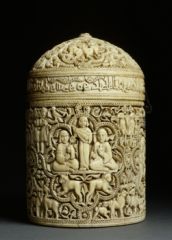
#57 Pyxis of al-Mughira Umayyad 968 C.E. _____________________ Content: This is an elaborately carved ivory container that depicts many figural, animalistic, and intertwining patterns. ___________________ Style: The scenes carved onto this contain represent royal hunting scenes and banquets. The design around the lid is calligraphic writing commemorating the birthday of Al-Mughira. |
Context: Piece like this one were usually found in the niches of Islamic Mosque and primarily used for decorative purposes. They could be made from ivory (like this one), metal, or wood and were commonly inlayed with glass or semi-precious stones. This particular pyxis was given as a gift to the Islamic prince al-Mughira for his birthday. The decoration is not only lavish in its design, but also in its subject matter. The piece depicts scenes of royal life, entertainment, luxury items, and animal symbols of royal blood. The writing, also is a script congratulating and commemorating al-Mughira's birthday. |
|
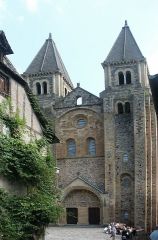
#58 Church of Sainte-Foy Conques, France Romanesque Europe Church: c. 1050 - 1130 C.E. _____________________ Content: This is a Romanesque church in France with a detailed westwork, two distinct towers, a domed transept, radiating chapels that surround the apse, as well as a circulating ambulatory. ___________________ Style: The church was built in a pretty traditional style, with a nave and intersecting transept to form the shape of a cross, as well as an apse. But the church was also styled with a few new innovations, like the dome over the transept and the radiating chapels around the apse. The design is still very stark and plan, although the ceiling is very elevated and allows in a lot of natural light. The ambulatory serves as a walkway and circles around in front of the radiating chapels. Most of the more intricate sculpture and design sits on the facade of the westwork and above the main entrance. |
Context: In Europe, at this time, it was extensively expensive to construct a grand church, so many people did not have immediate access to cathedrals like the Church of Sainte-Foy. So, people at the time would make pilgrimages to a certain few or perhaps many churches to worship in a formal setting and view the reliquaries. Therefore, these Romanesque churches were built with great size with the intention of awing the pilgrims that came to visit, since a church's significant was based on its popularity among pilgrims and how far people would travel to see it. The radiating chapels were used to house reliquaries, usually containing the body parts of saints that were considered to be holy relics. Pilgrims would flock to churches with particularly holy relics in order to worship by them or receive one of the blessing or miracles that the relics were thought to provide. The Church of Sainte-Foy also stood to communicate power, wealth (expensive to build), and stability as well as inspire faith. This was done though the impression-making decorations that cover the entrances the pilgrims used to come in through, like the Last Judgement Tympanum. |
|
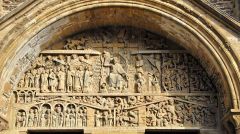
#58 Last Judgement Tympanum Over entrance to Church of Sainte-Foy _____________________ Content: Carved into an arch over a doorway, this tympanum shows the ultimate judgement that God bestows upon people when they die and how they will either end up in heaven or in hell. The piece is split down the middle using horizontal and vertical registers. The left half is decorated with saints and angels, with a Christ figure resting in the center of the entire tympanum. The right half represents hell, with many grotesque creatures being depicted in chains as they are led into hell. On the left side there are also depictions of people thought to be of the royal family of France at the time. ___________________ Style: By using the symetrical yet opposing techniques in representing heaven and hell, the tympanum manages to look cohesive but yet still able to convey its message. The horizontal and vertical registers that break up the piece are created with architectural representations or patterns meant to be the light of the Christ figure. There are also inscriptions along the horizontal registers. |
Context: This tympanum was one of the first impressions that the pilgrims received upon entering the church. It communicated how relevant it was to the pilgrim's lives and their deaths that they continue to piously worship the Christian faith to ensure they get to heaven. The disturbing images of hell sought to intimidate the pilgrims into making more pilgrimages, donating more to the churches, and partaking in good works so that they wouldn't have to go to hell after their death. In this way, the church was able to maintain worshipers. |
|
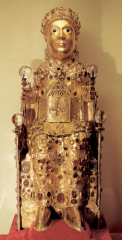
#58 Reliquary of Sainte-Foy In the Church of Sainte-Foy _____________________ Content: This is a small (18 - 24") tall statue sculpted from wood, gilded with silver, gold, and inlayed with semi-precious stones. ___________________ Style: The statue was sculpted in order to hold the relics of a saint. The gilded gold and silver would have been placed onto the wood and them molded and inlayed with stones to created the figural shape and decoration. |
Context: This was one of the reliquaries that pilgrims of early Europe would travel (sometimes on foot for very large distances) to see and pray beside. The reliquaries would be kept in the radiating chapels and the ambulatory would allow the pilgrims to walk around and view them. The reliquary of Sainte-Foy represents a reintroduction of sculpture but created for a intentional purpose rather than just for expression. The wealth of the reliquary meant to convey the connection between wealth, the church, and divinity or sainthood. Most of the inlayed stones were donated by pilgrims or townspeople, hoping the offering would make them look more favorable in the eyes of God. |
|

#59 Bayeux Tapestry - "Calvary Attack" Romanesque Europe (English or Norman) 1066 - 1080 C.E. _____________________ Content: This is a section of the entire tapestry (70 meters long) that shows soldiers in battle being attacked by a calvary (other men on horses). There are many flying spears and the men are dressed in full armor with pointed helmets and shields. ___________________ Style: Everything is stitched into the woven, linen cloth. This section also included detailed, embroidered registers separating the sections. It was sew using 8 colors of died yarn. The figures are shown in naturalistic but still simplistic poses and in the banquet scene, there is success in creating illusionary space. |
Context: This tapestry was made to commemorate the battle of Hasting and the Norman victory over the Anglo-saxons. The war succeeded in united all of England and most of France under the rule of the kings of Normandy. Although the battle is painstakingly detailed in representing the battle, it is unsure where its creation was commissioned by the victorious Norman royalty, or by the defeated Anglo-Saxons. It is now thought that the tapestry was a work commissioned by both groups as a way to solidify their identity as Normans and way made by artisans of both cultures working together. This is mostly supported by the banquet scene ("First Meal", where it is thought that both kingdoms converged and celebrated as one kingdom for the first time after the war. |
|
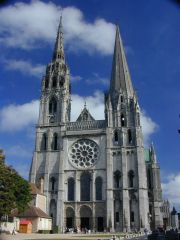
#60 Chartres Cathedral Chartes, France Gothic Europe Original: c. 1145 - 1155 C.E. Reconstructed: c. 1194 - 1220 C.E. ___________________ Content: This is a Catholic cathedral in France, consisting of two unmatched towers, jamb statuary and other decoration on the westwork, pointed arches, and an interior that stretches high up to elevated ribbed vaults. The facade includes a "rose window" that, inside, is adorned with stained glass. The westwork also includes three portals above the entrances that are carved with tympanums. ___________________ Style: The church was originally built in the Romanesque style, accounting for the large arches and simplistic right tower. When it was rebuilt, however, the right tower especially received a more Gothic, majestic makeover. The rose windows and other stained glass in the church hold scenes from the bible and other representational imagery and symbolism. The windows allow for the introduction of natural light into the large spaces of the cathedral. |
Context: This church is considered the epitome of the Gothic architecture that thrived in France. The towers and flying buttresses take the building to an astonishing height. The church is thought to hold, or to have once held, a relic from the Virgin Mary herself - a piece of the shroud that she wore when giving birth to Christ. This was considered an amazingly holy relic and most of the church was dedicated/designed to honor Mary. The rose window at the front of the church, for example, holds a stained glass piece that features the Virgin Mary at the center and other apostles, animals, and kings centered around her. At one point, the church burned down (and I think the relic survived and prompted the rebuilding), resulting in the mismatched towers and even further tribute to Mary. Some thought that the church burned because Mary was unsatisfied with its tributes to her image. |
|
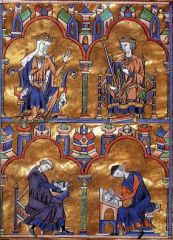
#61 Dedication Page with Blanche of Castile and King Louis IX of France and Scenes from the Apocalypse, from the Bible moralisee Gothic Europe 1226 - 1234 C.E. ___________________ Content: This is a page from the bible of moralisee depicting the Queen of France with her son, Louis IX. Below are two artisans, one writing and the other illustrating. The page is separated in half by horizontal registers and all the figures around surrounded by clover shaped arches with scenes of cities painted as borders. ___________________ Style: This bible was a form of illuminated manuscript. It was very large and highly ornamented. The dedication page in particular, used gold leaf to enhance the decoration. Queen Blanche is also shown as the Virgin Mary (iconography), with a similar dress and modified orant posture. |
Context: In her own story, Queen Blanche of Castile marries into the French crown and has a son, Louis IX. After Blanche's husband dies, she takes over the rule until her son is old enough to rule. But because of her choice to assume the crown of France to insure her son's rule, and the fact that she was a women, led to public disatisfaction with her every political move. Despite her unpopularity, Blanche continued to be determined in securing her bloodline's royal right to rule. The bible itself, like many made at the time, served as resources to communicate the religious stories of the bible and also to give royal families the religious morals that they should try to live and rule by. Still, the manuscripts were strictly for the use of the royal family and no one else, communicating to the lower classes that the ties between royalty and divinity were very close together. This particular codex includes a (pictured) dedication page showing Blanche, Louis the Ninth, and the creators (scribes) of the bible itself. The page was created as a tribute to the patrons (the royal family) and also the artist and scribe, showing the elevated status of religious artists for one of the first times. In fact, the scribe with the shaved haircut similar to the style of monks at the time, served also as a tutor for the young prince. This was considered a high position and the haircut was actually meant to symbolize higher social status, as the tutor was teaching and creating this bible for the future king of France. |
|
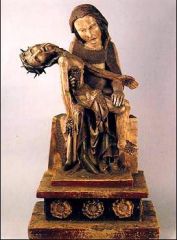
#62 Rottgen Pieta Late Medieval Europe (Germanic) 1300 - 1325 C.E. _____________________ Content: As a "pieta" (later to become a common art subject), this carved piece shows the Virgin Mary holding the dead Jesus Christ after he is taken down from the cross. Jesus still wears a crown of thrones and is shown as being very skinny and frail. The bottom of the statue also has three rose carvings. ___________________ Style: This piece is carved from wood and then painted. Although there was apparent attention directed towards the fabric of Mary's gown and the facial expressions of both people, the statue still fails to keep correct proportions and naturalistic movements. The figures themselves have exaggerated heads and too-small of bodies. As seen with many Germanic pieces, this pieta has a certain grotesque, emotional, powerful, and slightly dark influence in both subject matter, form, and color. |
Context: This piece was carved around the time when the Virgin Mary was gaining significant popularity within the religious populace as the "Queen of Christianity". Her admirers formed the basis on the "Cult of the Virgin Mary", which made the imagery of the mother of Jesus the central aspect of many churches and religious practices. Because of this, the pieta moment of when Christ in taken down from the cross and held by Mary takes on a whole new meaning. Instead of an emphasis on Christ's sacrifice, there is a greater understanding and significance to Mary's own sacrifice, as a mother, of her son. The enlargement of the heads and faces of the characters was actually done intentionally in order to better portray the wrought emotions of the scene and to better illustrate the sacrifice of Mary. |
|

#63 Arena (Scrovegni) Chapel, including Lamentation Padua, Italy Unknown architect Artist/painter: Giotto di Bondone Chapel: 1303 C.E. ___________________ Content: This is a small, family chapel made with an extended barrel vault and covered in vibrant frescos and lined with benches that served as pews and a small window and door. ___________________ Style: The interior was constructed with a simple basilica plan, with the inclusion of a small apse. The frescos themselves, however, are very proto renaissance. The frescos were a return to elaborate, decorative painting while still using bright colors and strong pigments. Separated into individual panels, the frescos communicate themes/stories from the bible. The floor is also nicely tiled and the windows are smaller versions of Romanesque arches. |
Context: At the brink of the Italian Renaissance, southern Europe was experiencing, for the first time since the fall of Rome, national stability, economical growth, political power, and religious power order. All of this led to the rise of a wealthy middle, merchant class that started commissioning personal art. Among these art pieces were the creation of small, family chapels for personal worship. Most families believed that their patronage of their own chapels made their look more favorable to God. Since the families had private patronage, they had control over what was painted within their chapels. In most cases, the patrons sought to have the frescos made to be more aesthetically pleasing that have them maintain the traditional ways of representing religious imagery. |
|
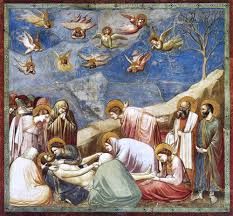
#63 Lamentation in Arena Chapel _____________________ Content: This is a sectional fresco made in the Arena Chapel painted by Giotto. Similar to the pieta, the lamentation is a representation of the moment when Christ is taken down from the cross and is being mourned by his mother and the surrounding saints, who all have large, gold halos. In the sky there are several cherubs flying around in different directions. ___________________ Style: This is an example of the stylistic return to artistic innovation that carried over from the classical influences of Greece and Rome. It was a step away from the generic forms and representations of religion widely used in the Dark Ages. The artist, Giotto di Bondone, gave the Lamentation a sense of depth through the inclusion of a background, middle-ground, and foreground. Some of the angels, too, show the use of fore-shortening to create depth. The organization in the piece and the positions and planes of the figures help make Christ the focal point, without placing him in the center. The figures themselves and their various gestures and naturalistic poses help create the image of humanistic apostles within a divine scene. Giotto is also one of the first to utilize chiaroscuro - the ability to apply value to subjects to create better form, depth, and soft, reflective light. It was primarily used in skin tones and the folds of fabric. |
Context: The reasoning behind the holdover of classical ideas in Italy is thought to have come from the close geographical location and contact the region would have had with Rome, as the capitol of the Roman Empire. The change from medieval arts to those of the proto renaissance happened gradually and took over 100 years to complete. The movement was propelled by changes like the softening of the Gothic jamb sculptures, the lessening of intimidation on the part of the Christian church and the increased use of emotion and humanistic elements to sway the public into the christian faith. Giotto di Bondone successfully, through the frescos of the Arena Chapel, introduced many renaissance techniques to the world. Giotto was one of the earliest renaissance painters that had well-developed techniques for 2-D surface painting and the creation of depth. Many of the humanistic techniques of the Lamentation, like the Chiaroscuro, were brought back from classical times by Giotto's works. At the time, it was common for artistic masters to have apprentices, create schools, and spread artistic ideas. It is thought that Giotto may have had an artistic master from who he took basic renaissance techniques and improved upon them in his own pursuit of finer arts. |
|
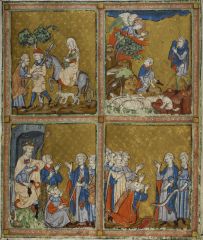
#64 Golden Haggadah (The Plagues of Egypt Scenes of Liberation, and Preparation of Passover) Late Medieval Spain 1320 C.E. _____________________ Content: This is a Jewish illuminated manuscript or codex decorated with the different phases of satyr and customs that came with the celebration of passover. _____________________ Style: The entire book contains many stories from the Old testament as well as more specifically Jewish traditions. The codex is made is a similar style to other early Christian books, with separated, lavishly decorated leafs and the existence of relatively simplistic figures. |
Context: The Golden Haggadah serves as proof of the similar ways in which Christians and Jewish people preserved their sacred texts and stories, as well as how both groups sought to educate the public through illustrations. |
|
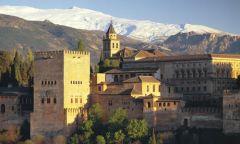
#65 Alhambra Palace Granada, Spain Nasrid Dynasty 1354 - 1391 C.E. _____________________ Content: The entire palace is actually a complex with 23 towers, a stone built exterior wall, many other building that, all together, could house over 40,000 people. There are also two main courtyards with water sources running through them. _____________________ Style: The complex was constructed with both Christian and Islamic influences. It is built like a fortress, made from cut blocks of a rose-colored stone and with large walls and towers. |
Context: The spread of Islam in North Africa eventually came to Spain, where the Islamic Empire was established, the Nasrid Dynasty being one of the Islamic ruling families. For a long time, the religions of Christianity and Islam conflicted over Spanish territory before the fall of the Ottoman Empire. This palace is named for neither the Muslim nor the Christian religions, but instead for the rosy color of the stones it was made of which were mined in the area. The floor plan (not pictured) was built in sections, expanding due to different additives and with relatively little organization. In the floor plan, it can seen that the palace has two courts and that the waterways in the Court of the Lions is in the shape of a cross. |
|

Court of the Lions Alhambra Palace Granada, Spain Nasrid Dynasty 1354 - 1391 C.E. _____________________ Content: Serving as an atrium/courtyard, the court of the lions contains a center fountain, surrounding pointed arches supported by thin colonnades, cover cloisters, and strictly geometric designs and animal sculpture. _____________________ Style: One of the most stylistic elements of this court in the inclusion of the fountain and the emphasis of the Islamic practice of always incorporating a water source into sacred areas. There is also a touch of Gothic architecture in the inclusion of the repetitive, pointed arches that surround the court, although these are distinctly Islamic. There are also many, many greek columns with Islamic capitals that form colonnades and provide ceiling support for the cloister walking spaces around the court. The court is a perfect example of the Islamic iconoclasm (lack or absence of human figures). Instead, the designs are focused on the elaborate carved designs that rest above the capitals and form the pointed arches. The only animalistic representation is that of the carved lion statues surrounding the main fountain. |
Context: The Court of the Lions is very representative of the Islamic influence that came with the rule of the Nasrid Dynasty. The incorporation of the many fountains and sources of running water were meant to be symbolic of the oasis(es) that had first allowed for the spread of Islam to travel across the deserts of North Africa. The fountains also provide evidence that the architects and designers of the palace had a mild understanding of water pressure and were able to use the flow of water from the mountains to create fountains. Again, there is so much emphasis on the geometrical designs and carvings of the court than anything that relates to figural representations, as was common for Islamic practices. |
|
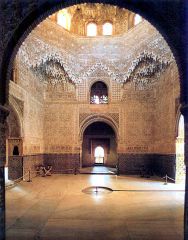
Hall of the Sisters Alhambra Palace Granada, Spain Nasrid Dynasty 1354 - 1391 C.E. _____________________ Content: This is actually a picture of two intersecting hallways that is topped with a large dome. _____________________ Style: This hallway still contains a water element, with a tiny canal bring water into a fountain. The decoration of the dome is very Islamic and is patterned with thousands of recessed, "combed" niches that create a prism-like, stalactite look. |
Context: The height and layered, sophisticated decoration of the domed halls speak to the high Islamic influence in the area. Many of the aspects of the hall speak to Islamic traditions like the inclusion of water (again, representing the oasis) and the pointed features of the dome. |
|
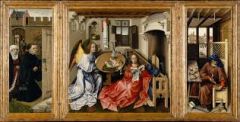
#66 Annunciation Triptych (Merode Altarpiece) Workshop of Robert Campin 1427 - 1432 C.E. _____________________ Content: This is a three sectioned painting showing different religious imagery. The first scene is one of two monks or saints at a city door, the second shows an angel and a women in a domestic setting. The last section shows an old man, probably an artisan, working at a table with a city scene showing through the window behind him. _____________________ Style: This painting brought in the introduction on a new paint called egg tempera that, when applied to the wooden surface, can be layered to create more vibrant, realistic colors. This happened because the paint, while very durable, was slightly transparent when applied in only one layer. In this altar piece, there is also a continuation of the chiaroscuro in the rendering of the fabric and softening of the skin tones. There is abundant humanism in the piece as well, with the figures all having naturalistic/realistic expressions, humanistic angels instead of iconic ones, and people shown in all different positions and looking in different directions. Altogether, the people are very approachable. The painting also uses the style of "Maniera Greca" or "Greek Style". The painting style is also a mix of Byzantine and Italian ideas that leads towards the coming renaissance. There are also advancement in created space and depth, like the bend where the old man is seated, where the bench recedes from the foreground into the middle-ground. The corners of the rooms also illusionary depth and one-point perspective. There are also tiny proportions of space, mostly shown through the constant (in all three panels) presence of a far-off background (distant subject matter), where seen from over a wall or through a window.
|
Context: Three paneled, wooden pieces like this were abundant in the Early Renaissance and sat behind altars in churches to serve as a backdrop. Most were decorated with biblical scenes, but always with humanistic elements. Most of the altarpieces were commissioned by wealthy Christians who were sometimes depicted in the paintings themselves. |
|
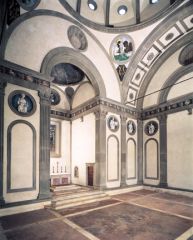
#67 Pazzi Chapel Basilica di Santa Croce in Florence, Italy Architect: Filippo Brunelleschi 1429 - 1461 C.E. _____________________ Content: This is a small, central planned chapel designed by Brunelleschi to incorporate classical ideas but at the same time, reinvent them. _____________________ Style: The chapel is full of strong, curving roman arches (very classical) as well as an open area in front of the apse which contains an altar. The chapel is a creamy white paired with a dusty grey-green that enhances the architectural lines. There are also smaller frescos and portraits done by Brunelleschi in the pendentives and empty spaces of the chapel walls. |
Context: This chapel, and really, all of Brunelleschi's work set the standard for the Italian Renaissance architecture that kept returning to classical styles. |
|
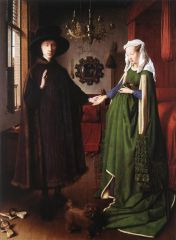
#68 The Arnolfini Portrait Jan Van Eyck 1434 C.E. _____________________ Content: This is a formal portrait of a couple in a household setting. There is a small dog on the floor, a chandelier hanging from above, lots of textile and fabric elements, and also a light source coming from a window on the left. The reflection in the mirror between the two figures is showing the backs of the subjects and the reflection of the artist actively painting the portrait. _____________________ Style: Because the piece was painted with oil on wood, it allowed for brighter colors and more refined detailing. The oil paint could be layered, blended, and polished to bring out the lush, rich colors, the high realism, and naturalism in terms of the skin tones and shading of the fabric. The paint also allowed for remarkably tiny details, like the mirror reflection or the light shining on the beads hung on the wall. |
Context: The rendering of this portrait is very Northern Renaissance in terms of its subject matter. In the North, the ideals of Protestantism were quickly convincing people to embrace their individuality and personal connection with God. The North was also more liberal than Southern Italy or Rome and allowed for individualized portraiture to be made without many, or any, religious connotation. |
|

#69 David Artist: Donatello 1440 - 1460 C.E. _____________________ Content: This shows David as a small, nude, young man standing victoriously over the severed head of Goliath. David is also holding his sword and wearing a hat. The sculpture is made of bronze and stands approximately 5' 2" tall. _____________________ Style: Donatello's David was sculpted with the intention of rebirthing the classical techniques of Greek/Roman sculpture. David is shown standing the classical contrapposto stance, with relaxed and naturalistic positioning. David is also nude, a artistic quality that all but vanished during the Dark Ages, but is brought back because it was used in classical sculpture. The sculpture is also strangely feminine, with soft, naturalistic features. |
Context: This David was commissioned by the Medici family of Florence, Italy, where Donatello was a favorite artist. He gained fame in Florence, mostly through sculpture, but also through some painting. The story of David v. Goliath, however, had special meaning to the up and coming city of Florence and its ruling Medici family. At the time, Florence was attempting to become economically, socially, and maybe even religiously separated from the all-powerful city of Rome. In the story, Florence found representation of itself in the protagonist of David, with Rome being Goliath. The biblical story, ultimately, represented Florence rising up against the large, stronger, Catholic state of Rome. The Florentine people considered the story very dear to them and there are still many representations of Davis throughout Florence. The particular, feminine form of David in this sculpture, however, is more representative of the opening of subject matter that happened at the time as well as the more varied interpretations of biblical stories that were being expressed through various art forms. |
|
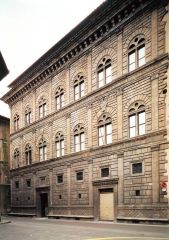
#70 Palazzo Rucellai Florence, Italy Architect: Leon Battista Alberti 1450 C.E. _____________________ Content: This is large house that was once the private residence of the Rucellaisa wealthy merchant family of Florence. It has many classical elements right along side very modern ones. It is made from cut stone blocks and concrete, with a wooden interior. _____________________ Style: The first, most utilized technique of this building was the intentional use of the number three as a reference to the holy trinity. The construction involves roman arches over all the windows, post and lintel doorways, and the all-important illusion of columns. Alberti modified the traditional and classical standards of columns and created the illusion of columns against the flat facade of his building instead of projecting them. This made the columns more of a decorative element than a necessary structural requirement. The capitals of the columns still protrude slightly. The building is broken up into three sections by horizontal registers. The design of each section is similar to that of the Colosseum, with successive roman arches and the progression from doric, iconic, and corinthian columns. The horizontal friezes also serve to balance out the vertical movement of the house, and the protruding roof (cornice) keeps the eye centered around the facade (instead of continuing up). |
Context: The design of this private house really set the standard for even modern day construction. The fact that it was a wealthy patron that was still a private citizen proved the fact that, at the time, common people and families were gaining wealth and rising in population. |
|
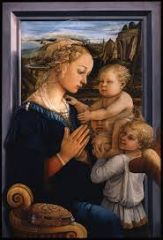
#71 Madonna and Child with Two Angels Fra Filippo Lippi 1465 C.E. _____________________ Content: This is a representation of the Virgin Mary (Madonna), with her hands shown in a prayerful positions. The infant Jesus is beside her, holding onto her shoulder and being supported by two small, cherubs. All the figures are in front of a blue frame which displays a rocky, expanding landscape. The virgin herself is seated on an elaborate stool and has the faintest representation of a halo around her hair. It was painted with egg tempera on wood. ___________________ Style: Full of naturalism and humanistic qualities that convey the grace, beauty and youth of the Virgin and her position as a loving mother. In fact, she is shown to be so enraptured by her child and the cherubs, that she doesn't even make eye contact with the viewer. One of the cherubs, however, does look out to the audience with a humanistic, clever, and mischievous look which engages the viewer into the scene. The baby Jesus is also more realistically represented as a small, chunky infant - rather than the former representations of baby Jesus as a small man. Mary's faint halo conveys saintly and religious ideals in a more subtle way than the large, golden discs above character's heads that were seen in the Dark Ages; the halo served as part of the humanistic impact of the Renaissance, allowing religious icons to seem more human and less overtly divine. The vast background behind the Virgin shows the emergence of areal perspective and the use of shading and value to communicate depth and distance. The painted frame helps to create a large sense of depth and separation of background and foreground. |
Context: The painting was done by a monk called Fra Filippo who, after falling out of favor in his monastery because of his behavior, fell into favor of the Medici family. The Medici's recognized his artistic talents and "saved" him by supplying their patronage to his works. It was also around this time that the printing press was eliminating the need for large, illuminated manuscripts. Instead, art turned to the humanistic expression of religious ideas that satisfied the expectations of private patrons like the Medici family. The artists also probably used live models for this painting. |
|
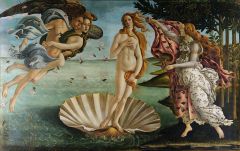
#72 Birth of Venus Artist: Sandro Botticelli 1484 - 1486 C.E. _____________________ Content: Based on the Greek myth/poem, this painting shows how Aphrodite floated out of the sea on a cockle shell while being blown inland by the wind god Zephyrs to her sacred island of Cyprus. There, she is met a nymph who comes to meet her and cover her nude figure with fine cloth. The painting was made with tempera on wood and standing 6' x 9' - a significantly larger size than most singular paintings of the time. _____________________ Style: Botticelli made this piece with the intent of returning to the classical themes of Greece and Rome. In doing so, he also utilizes the techniques of areal view, chiaroscuro shading (in the skin tones), and nude subjects. Also, as his artist's "trademark", Botticelli's figures are stylized in their faces but also have realistic profiles. |
Context: This piece was yet another painting commissioned by the Medici family. Although praised for the renaissance talent displayed, the painting was still largely criticized for its scandalous subject matter and sensual depiction the goddess Venus. The painting was also straying from the traditional, Christians subjects of art, which was uncommon until the Renaissance. At this time artists were also beginning to develop their own styles, as did Botticelli in this painting (see "style" section). |
|
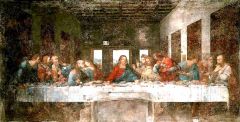
#73 Last Supper Artist: Leonardo da Vinci Milan, Italy 1494 - 1498 C.E. _____________________ Content: In this fresco, the subjects are of Jesus Christ and his disciples (along with the supposed figure of Mary Magdalene) dining all at one, large table. The scene is actually supposed to be of the moment when Jesus tells his followers that one of them will betray him. The scene takes place is a nondescript room, with traces of a far-off landscape in the back windows. As a fresco, the piece is painted on a wall and is about 14' x 30' in size. _____________________ Style: The most impacting stylistic element of this fresco is the use of one-point perspective and motion of the figures to direct all eye contact to the figure of Jesus Christ, who remains in a serene disposition while those around him fall into chaos. This is done both through the lines of the room and ceiling, the inclination of heads around the table, and the figural gestures and expenditure of arms and figures directed towards Christ. |
Context: Although this piece was painted by the famous Leonardo da Vinci, it was commissioned by a lesser known monastery in Milan to serve as an inspirational fresco in the dining area of the building. The fresco, today, is so deteriorated because when da Vinci painted it, he was experimenting with a new mixture of both the egg tempera and oil paints on the fresco plaster. |
|
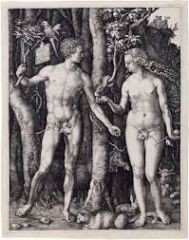
#74 Adam and Eve Artist: Albrecht Durer 1504 C.E. _____________________ Content: This is a black and white print showing Adam and Eve in a slightly more European looking forrest surrounded by various symbolic animals and objects. There is a tropical parrot, mini elk in the background, cat, rabbit, mouse, and an ox. _____________________ Style: The most stunning aspect of this print in the encapsulation of so many details in a relatively small space. Both Adam and Eve are in the classical contrapposto position. Most of the animals around are either in a predatory-prey relationship or not meant to be in a Germanic forest setting. All this is mostly because of Durer's strange, different, and melancholic style. |
Context: As industry for easily printed arts increased, Albrecht Durer was one of the artists that not only understood the increasing demands but succeed in the business with his own art as well. His prints was representative of the Northern Renaissance style that was usually darker and more grotesque than the southern Italian style of art. His success in both the artistic and entrepreneurial aspects of Northern Renaissance Art represented the overall rise of the artist as a social standing, and also his own pursuit of recognition. Oftentimes shown as a very vain character, Durer would even put himself into his works just to boost his image. Durer's way of created art remained productive and efficient. He became a master at printing individual sheets off a printing press, all made from one original palate. But, instead of using the wood-cut blocks that many prints were made from at the time, Durer used etched plates (either metal or ceramic) that lasted longer than the wood cuts and allowed him to make more prints to sell. The plates were designed with negative space and detailed with hatching and crosshatching to create shading. Durer's work illustrated the high technical ability of print artists to create detailed and profitable art. |
|
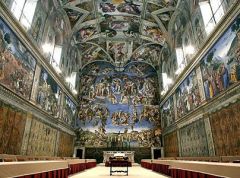
#75 Sistine Chapel Vatican City, Rome, Italy Artist: Michelangelo ceiling: 1508 - 1512 C.E. altar: 1536 - 1541 C.E. _____________________ Content: This is a chapel in the Vatican City intricately decorated with many, many paneled fresco paintings. It was painted by Michelangelo and some helpers who were supervised by Michelangelo. The paintings cover all the walls and the ceiling of the chapel. _____________________ Style: The frescos were done is a very high Renaissance fashion. The chapel architecture by itself consisted of rib and groin vaults intersecting along the barrel vaulted ceiling. The sections created by the architectural elements actually serve as the borders between frescos and different biblical scenes. The curve of the ceiling in combination with Michelangelo's relatively unexperienced stance on frescos led to the characters having movements that are more like sculptures. Most of the paintings on the celling were categorized in stories from the Old Testament stories telling of the rise, fall, and redemption of humanity. The altar wall was painted with images of the flood that cleansed humanity in order for the redemption to begin. The entire chapel was also built in a simplistic basilica plan to indicate a return to the "perfected" architecture of classical times. |
Context: The painting of the Sistine Chapel was commissioned by Pope Julius II in connection with the Catholic Church in the Vatican City (which operated and still operates as a separate governing body from that of Rome or Italy). The church and the pope, in order to convey their embracement of humanistic ideals and also display their religious authority and ability to indulge in fine arts, had the chapel elaborately painted. Michelangelo, amazingly, had little experience up to this point with fresco work and it is even supposed that he scraped several earlier attempts at certain frescos. Idealistically, Michelangelo considered himself a sculptor and transmuted some of the thick, twisting features of classic sculpture into the figures he painted. Altogether, the piece is the highest representation of the glory days of the Renaissance, with bright colors and realism, naturalism, and expressionism abound. |
|
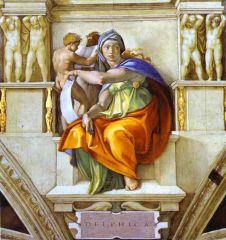
#75 Delphic Sybil in Sistine Chapel _____________________ Content: This is a sectional fresco showing a finely robed woman, sitting on the steps of what looks like an altar, holding a scroll and looking off to the right. Behind her are golden statues, architectural elements that were painted in, and two other figures. _____________________ Style: This particular scene incorporates one point perspective to blend the actual architectural elements of the chapel into the architecture painted into the fresco scenes. The blending of the two allowing for the frescos to remain uninterrupted but still organized. Michelangelo's incorporation of robust figures and exaggeration of humanistic motions are also present with a variety of poses within the single scene. |
Context: The Delphic Sybil holds the same historical context about the chapel and artist as the rest of the frescos. But, the particular subject matter of this fresco is more unique. While most of the church is decorated with biblical scenes and messages pertaining to Christianity, the Delphic Sybil is a figure rooted in Greek Mythology. She is a representation of the Delphic Oracle (or Sybil) that was thought to be a oracle of the future that would live inside a particular young women and deliver prophesies. Her story and its depiction on the Sistine Chapel ceiling shows a significant return to the stories of ancient Greece, even in a building saturated with Christian and Catholic ideology. |
|
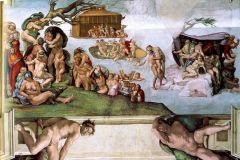
#75 Panel of the flood in Sistine Chapel _____________________ Content: This is a fresco showing the biblical description of the great flood that was unleashed unto the world in the Old Testament. There are a multitude of figures huddling on bits of land and rock with some types of boats and houses floating out on the water. _____________________ Style: Once again, the form of all the figures in very exaggerated, bulky, and realistic. There is use of shading throughout the water to create the illusion of depth on the horizon. The two figures below the scene are also resting on more painted architectural elements that separate the fresco. |
Context: Again, the Panel of the Flood has a lot of the same context as both the entire chapel and the Delphic Sybil. The scene is important in a religious sense, however, in the fact that it was a representation of God's purification of humanity (washing away the sins, so to speak) so that the human race could continue on to its redemption. |
|
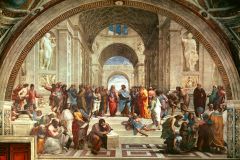
#76 School of Athens Raphael 1509 - 1511 C.E. _____________________ Content: This is a huge scale fresco painting (19' tall x 27' wide) that decorates the pope's residence in the Vatican. The painting is of a classical courtyard filled with all the great classical thinkers of the time, including Aristotle and Plato in the center. It is also thought that Raphael, the artist, painted himself in the far right corner and that the dark, brooding character off to the center-left was meant to be Michelangelo. _____________________ Style: Besides using the obvious techniques of the Renaissance, like realism and strong color, Raphael also developed a way of arranging his many characters. All the people are arranged in a narrow ellipse that leads the eye around the composition to each and every group of figures. The figures are also grouped together in order of their classical train of thought or study, be is religion, philosophy, science, law, or poetry (similarly the other decorative frescos in the Vatican have certain themes along the same lines). The entire piece was created using the wet on wet plaster technique. |
Context: Again, this fresco was commissioned by Pope Julius II and was symbolic of the rebirth of classical ideology and a celebration of the greatest classical thinkers that there were. Pope Julius II was very aware of his public popularity and also the strong connection and advocation the public had with the ideas of humanism and other themes of the Renaissance. Therefore, to remain in favor, the pope patronized the creation of Renaissance art that expressed the very basic ideals of the Renaissance and the return to classical humanism. These decisions helped the pope retain his image as both a spiritual and a advocate for humanist, which gave him more public popularity. Raphael's inclusion of himself and fellow/adversary painter Michelangelo represented the first stages that artists took in elevating their own status and self-implimenting the reoccurrence of their own image in important art works. It was a stance for the artist(s) own personal power and ability over the mediums of fresco work. |
|
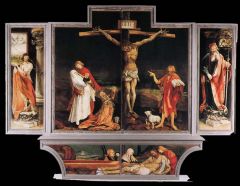
#77 Isenheim Altarpiece (closed) Grunewald 1512 - 1528 C.E. _____________________ Content: When the altarpiece is closed it shows the images of Christ on the cross, flanked by the saints Anthony and Sebastian. The altarpiece was carved from wood and then painted with oil paints. _____________________ Style: The constructive elements of the piece itself include a supporting platform (a prodella) and hinged doors so the altarpiece could have different positioning. The style is very much Germanic in the use of grotesque features, emotional expression, and dark colors.
|
Context: This is a Germanic piece that was made for the Catholic Church even though the rise of Protestantism was just happening in that area of Europe. The saints of Anthony and Sebastian were individuals who were thought to provide safety, heal sickness, and preform miracles in hard times, like when the Black Plaque swept over Europe. Even though this altarpiece was created long after the black death riddled Europe, the saints are shown here to communicate the Catholic Church's stability in times and illness and mass death and also the religious potential of the saints to protect and heal. |
|
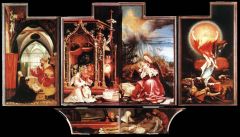
#77 Isenheim Altarpiece (opened) Grunewald 1512 - 1528 C.E. _____________________ Content: This is how the altarpiece looks when it is unfolded. It shows the progression of Christ's life through individual scenes. The first is Mary announcing the birth of Christ and the last shows the resurrection of Christ after his death. |
Context: The chronological order of the events of Christ's life provides, for one of the first times, the full scope of Christ's existence and gives the full effect of his resurrection, as the altarpiece was only opened on holy days, primarily Easter. The altarpiece was also the first time that is is shown that an painter, Grunewald, worked actively with a craftsman in collaboration to create this piece that has important carpender-created and painted aspects. |
|
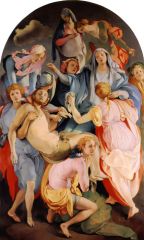
#78 Entombment of Christ Jacopo da Pontormo 1525 - 1528 C.E. _____________________ Content: It is unsure whether the moment encapsulated in this piece is supposed to show the moment when Christ is taken down from the cross or the moment when he is entombed. Either way, the painting shows a multitude of people surrounding and carrying a dead christ, while Mary reaches out towards her son's body, clearly emotional and upset. _____________________ Style: The style of this piece is called "Mannerism" (although still in the early stages at this point) and works with lighter shades, superficial expression, sense of weightlessness, and organization that places subject matter around the frame, leaving the center empty. The painting also lacks any substance of a background of earthy setting, although there are signs of the ground and some clouds up above the figures. Most of the figures themselves are elongated and move un-naturalistic ways. Again, there is a tangible sense of organized chaos and motion, as well as unrealistic weight and balance. The emotional characteristics of the figures are appropriately saddened and stressed, but (as common in Mannerism) they also seem to be overwrought and artificial. |
Context: The changes in the traditional ways, even the Renaissance ways of depicting religious and emotional biblical scenes change dramatically with the introduction of Mannerism. The switch to more experimental styles might have been influenced by the impact of Protestant ideas and the belief in individualized expression through religion (as well as a personal connection with God). |
|
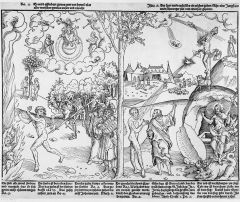
#79 Allegory of Law and Grace Lucas Cranach the Elder 1530 C.E. _____________________ Content: This is a wood-block created print that appeared in an early newspaper that displays an allegory for the ideas of "law" and "grace". The print is divided into right and left sections both showing different versions of Judgement Day according to the Catholic ideas and according to the Protestant ideas. On the left, there is Jesus sitting in the sky and a group of skeletons on the ground herding a man into a bonfire that represents hell. The right panel shows the common man being blessed with light being reflected off of Christ on the cross. _____________________ Style: Cranach the Elder, similar to Durer, created art for mass publication and production. The prints were made from detailed wood cut blocks with defined background, middle-ground, and foreground. The figures here are still stylized but realistically detailed. |
Context: Lucas Cranach the Elder himself was closely associated to Martin Luther and the ideology of the Protestant Reformation. Cranach was not only a print maker, but also a oil painter, entrepreneur, and a believer in an individual's rights to control their own fate. His print here dealt with the ideas of salvation and the difference between the Catholic doctrine and the new Protestant teachings. These prints also happened around the time of when the Reformation was in full swing (about 10 years after Matin Luther posted his 95 thesis). |
|
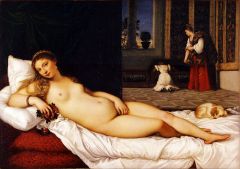
#80 Venus of Urbino Titian 1538 C.E. _____________________ Content: This was one of the first pieces painted with oil on canvas. The subject shows a reclining, female nude lying on a couch covered with pillows and cloths. The nude women is also holding a bunch of flowers. There are two women in the back, on standing and the other leaning into a chest. Behind those two figures is a window showing a darkening sky and the outlines of trees. _____________________ Style: The painting is done in a very Venetian style. There is an incorporation of the well-known "Venetian red" along with the very deep color palate. The artist also uses linear perspective and attention to depicting the cloth. The subject matter, too, brings in a new (historically repeated) subject of a reclining female nude that has no religious connotation. |
Context: First of all, the use of canvas and oil paints together sets the standard for future artistic materials. Because the painting was made in Venice, it carries the rebellious subject matter that seems to stray from the religious subjects of Rome. At this time, Venice was a thriving city-state that had built its own economy due to its easy access to port and trade systems. The freedom that Venice enjoyed from larger, governing city-states like Rome was expressed through the art. Most private, wealthy citizens began commissioning their own arts that did not have to incorporate any religious matter. The title of the piece, too, relates back to ancient Roman mythology. |
|

#81 Frontispiece of the Codex Mendoza Viceroyalty of New Spain 1541 - 1542 C.E. _____________________ Content: This was a codex - a decorated book/manuscript with two hard covers on either side. This page is covered with Aztec pictograms, the image of an eagle on a cactus, and large blue lines bordering and intersecting the page. _____________________ Style: The style of the codex is made with Aztec influences alongside Spanish commentary. Most of the illustrations were done by or at least influenced by Aztec artists so they carry the styling of that culture. |
Context: The Codex Mendoza was created to celebrate the Spanish (the royalty of the area after the Islamic, Nasrid dynasty) conquest of Mexico and most of Southern America. The book serves as a "autoethnography", a self-created documentation of the Southern America colonies by Spain. It was one of the first artistic indications of the European colonization in the New Words. |
|
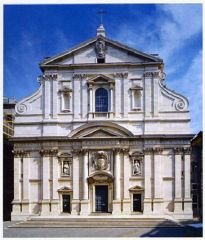
#82 Il Gesu, including Triumph of the Name of Jesus ceiling fresco Rome, Italy / Giacomo da Vignola plan (architect) Giacomo della Porta, facade (architect) Giovanni Battista Gaulli, ceiling fresco (artist) Church: 16th Century C.E. Facade: 1568 - 1584 C.E. fresco and stucco figures: 1676 - 1679 C.E. _____________________ Content: This chapel is full of baroque style and innovations in architecture. The church itself was made with an expanded basilica plan. The nave was made wider and smaller side aisles with installed on both sides. The church includes an apse, but also minimizes the size of the transept and side chapels, reverting to a more classical look. The facade includes the introduction of the scroll buttresses or "Della porta" to unify the excessive, horizontal space that the larger nave presented. Overall, the architecture and design of the Il Gesu transmutes the stylistic elements of the Right Renaissance and Early and Late Baroque. |
Context: The title of the building translates as the "house of Jesus" and was the central, mother church to the people of the Jesuit faith (a religion that is based entirely around Jesus Christ). The Jesuits tended to have a focus on education and missionary work in colonies of African and the New World. Because the church served as a central establishment of the Jesuit faith, it was building with the intent of being able to contain a very large number of worshipers at any given time. This resulted in the expansion of the nave and the introduction of new elements on the facade to keep the church pleasing to look at. |
|
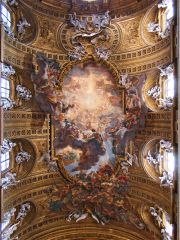
#82 "Triumph of the Name of Jesus" ceiling fresco in the Il Gesu _____________________ Content: This is a fresco created on the Il Gesu ceiling that shows a multitude of angels, figures, and saints flocking towards a distant light. Within the light, there are the initials of Christ (being I.H.C.). The letters seem to be emanating the godly light throughout the entire scene. Some of the figures and background of the fresco overlaps into the gilded gold architectural elements of the actual ceiling. ______________________________ Style: The styling of the fresco is over the top and very similar to the baroque styles being created in France. The fresco flows into and covers some of the architectural elements in an attempt to create the illusion that the image of Jesus (and his name) is expanding above and that the ceiling of the church is really a segway into heaven. The artist did this by glazing over the actual gold of the ceiling and expanding the fresco into that area. The artist also painting shadows extending along the real, gold elements so that it looks as if the light in the painting is shining on the actual ceiling. The light is symbolic of the power and glory of Christ. |
Context: The dramatic effects and styling of this fresco still serve to inspire the faith of the Jesuits in the people who came to the central church of Il Gesu to pray. The use of Christ's name appealed to many, many christian people and could be interpreted in many other ways, leaving the Church open for people to start attending. The central form of Jesus (or his name) also communicated the total emphasis that the Jesuit faith put on Christ and the most important entity for their religion. |
|
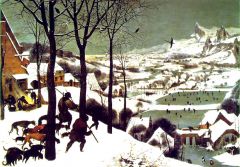
#83 Hunters in the Snow Pieter Bruegel the Elder 1565 C.E. _____________________ Content: This shows a group of hunters, followed by dogs, coming back into a village covered in snow. There are dark, barren trees, iced lakes, and far-off mountains. ___________________ Style: The painting is made with areal perspective and a strong sense of depth and distance. The figures are simplistic but the features of the village are detailed. All the same, the painting's strong intention of reality makes it so not all of the pictured activities are idealistic (one of the dogs is supposedly pooping). |
Context: The influences on this painting are from the Protestantism that thrived in Northern Europe around this area. The artist, Bruegel, was famous for this paintings of casual, informative, intimate scenes. He was influenced by the personal practices of Protestantism to start depicting the life of the common people in his art, hence the village scene and detailed realism. This painting also includes over 100 painted representations of proverbs to remind the people that viewed it of the morals and ideals from which they should live their lives. |
|
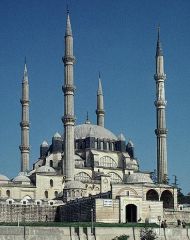
#84 Mosque of Selim II Edrine, Turkey Sinan (architect) _____________________ Content: This is one of the more important Mosques that was built during the Islamic Empire in Turkey. The entire complex (as can be seen in the floor plan) also includes a school, hospital, offices, and a surrounding bazar. The Mosque itself holds the traditional elements, along with four minarets at each of the corners of the complex. ___________________ Style: Similarly, the style of the Mosque is also very traditional. The Mosque was built on a central plan with flying buttresses for support. The interior was designed with the classic Islamic patterns based on geometrics and mathematics (including the reappearance of the candy cane pattern). Also on the interior, clusters and columns stood to form massive pendentives and piers, which were then decorated. There is also a huge, circular chandelier hanging, suspended by wire, above the main worship area. |
Context: Selim, a Sultan who commissioned the Mosque, challenged Sinan, a well known Islamic architect, to built the Mosque in such a way that it rivaled any Christian Romanesque or Gothic Cathedral even created. It was a way to shown that the Islamic Empire was equally as powerful as the Christian kingdoms and acted as a tribute to the Ottoman Empire against the rival European powers. The mosque was also built in Turkey which, at that time, was a connecting point between Russia and Northern Europe with the eastern countries. Turkey sat right on the Basafer strait, which was the quickest way to travel from west to east. Because of this, Turkey gained strength and wealth within the trade that their location intersected into. The complex around the Mosque was created so that the mosque remained the center of the community.
|
|
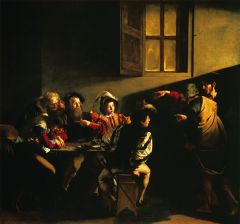
#85 Calling of Saint Matthew Caravaggio 1597 - 1601 C.E. _____________________ Content: This shows a group of people sitting around a table in a relatively private, indoor setting. The figure entering on the right is Jesus (with a faint halo) and he is shown pointing to St. Mathew, who in turn, points to himself in disbelief. A common figure is shown in front of Jesus, blocking the audience's view of him. Also, there is a clear beam of light coming in from the right, above Jesus' head that illuminates the darker tones of the scene. The piece was also oil on canvas. ___________________ Style: The rendering of this painting is very different from the traditional approaches that were normally taken towards religious subjects. For one, Christ is shown with a barely-visibly halo, making him seem less divine and more humanistic and approachable. Christ's hand gestures are also very similar to those of God in Michelangelo's "The Creation of Adam" fresco in the Sistine Chapel. Also, Christ is not shown as the center of the composition. The light that is shown is representative of the glory of God as it comes to contrast and to illuminate the dark composition of the interior space. |
Context: This was one of the first Southern pieces to aline with the Renaissance ideas produced in the North. Canvas became a popular medium because it could be easily transported and could be shaped to a specific patron's vision. This was useful at the time because many people began to be more mobile in the search for wealth and the chance to "make their fortune". This particular painting by Caravaggio was made for a chapel in Rome, commissioned by a Cardinal. Of course, Caravaggio was famed for his work but always ended up putting some unique twist into his work. In this case, it was the incorporation of Protestant and Northern techniques and the emphasis on the common setting and common figures (with the exception of Jesus) that are relatable to a larger audience. Caravaggio himself grew up in a simplistic setting and later spent the remainder of his life running from a past crime and painting to maintain a living. |
|
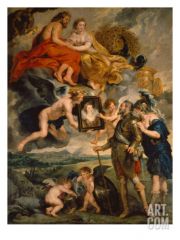
#86 Henri IV Receives the Portrait of Marie de' Medici, from the Marie de' Medici Cycle Peter Paul Rubens 1621 - 1625 C.E. ___________________ Content: (Oil on Canvas). This shown Henry (king of France at the time) being given a portrait of his wife by some hovering angels. There is what looks like a solider standing behind the king, cherubs on the ground near the kings feet, two semi-nude figures sitting on the clouds above, along with two peacocks and an eagle, with a majestic landscape in the background. The painting was part of a series of over 20 canvases, with this one being about 13' x 10'. ___________________ Style: This is very much in the style of the French and Southern Baroque, with dramatic figures and styling meant to be overwhelmingly beautiful and detailed. |
Context: The artist of this painting came from Flanders, a country in Europe that had belonged to the Spanish and then the Dutch, resulting of a mixed culture that was both southern and northern. This is conveyed in Ruben's painting as well, because they are painted with a mixture of techniques from both the Northern and Southern Baroque styles. The subject matter itself was a royal attempt to document the life of Marie de' Medici and how she came into the French royalty with an elevated status of Queen (though marriage). This might explain the continued religious imagery in the piece in order to show the connections between divine and political authority. The style of the painting (and the influence of Baroque in general) came from the Catholic Church's "Counter-Reformation" that utilized fantastic arts (faith propaganda) to persuade the public to covert back to Catholicism. |
|
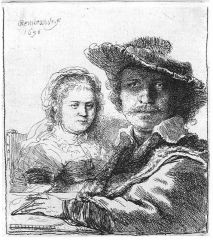
#87 Self-Portrait with Saskia Rembrandt van Rijn 1636 C.E. _____________________ Content: This shows The Rembrandt, with a large feathered hat standing beside a young woman (presumably Saskia, his wife) wearing a veil. The man's hand is also seen holding a pencil and posed above a paper surface. The artist's signature is also shown in the upper left corner. ___________________ Style: There is certain theatrical style to this piece. The Rembrandt shows himself in classical clothing (same with his wife) and in a direct, forward, and dominating position in the piece. His wife sits slightly smaller to his left and is again adorned with theatrical clothing. There is a multitude of shading and shadow within the clothing and on the Rembrandt's face as his hat blocks the light. |
Context: As an artist, the Rembrandt van Rijn seemed to want to portray himself within his artwork and also, as seen by his position in holding the writing utensil, as a craftsman and artist, active in his trade. This piece is actually referred to as an etching, meaning it was created with a metal plate. In the process of creating these etchings, a metal plate would be coated with a waxy material (acid repellent) which was then etched into with a needle to expose the metal in certain areas to create a scene or figure. The metal would then be dipped in acid, which makes lines (deep or shallow depending on the amount of acid) into the metal. The metal plate is then inked and put through a printing press to create hundreds of copies of prints. The Rembrandt was also know for his happy marriage to his wife Saskia, and it is thought that his self-portrait is actually meant to be a marriage portrait. |
|
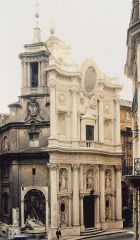
#88 San Carlo alle Quattro Fontane (and the floor plan explainations) Rome, Italy Francesco Borromini (architect) 1638 - 1646 C.E. ___________________ Content: This is a small, curving church built with tons of decorations (especially on the facade) the are very Baroque. Style: Unusually in its layout and design, this church was meant to convey the shape of a Greek cross with curving edges. The facade is similarly undulating and Baroque, with niches, statues, projecting and indented shapes, columns, designs, and much more. The only real constant pattern in the design in the repetition of the triangle, symbolic of the holy trinity. |
Context: The Italian translation of the church is "Saint Charles at the Four Fountains”. The church, when commissioned was given a very small, cramped lot for its construction, resulting in the curving and unique floor plan. The commission came from a small monastery for a community of Spanish monks. |
|
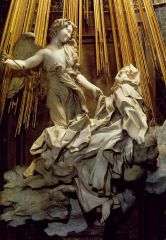
#89 Ecstasy of Saint Teresa Cornaro Chapel, Church of Santa Maria della Vittoria, Rome, Italy Gian Lorenzo Bernini 1647 - 1652 C.E. ___________________ Content: This shows saint Teresa, among the folds of fabric, in a physical position of ecstasy with a small angel standing over her, holding a metal arrow. This is also a marble sculpture. ___________________ Style: The styling of this sculpture is made with large amounts of sexual, physical, religious, and technical expressions. Teresa's heavy material grounds her as a representation of the earth, and the light fabric and wings of the angel portray him of one as the heavens. The gilded gold behind the figures was also designed by Bernini. As a "dramatist", Bernini created a hidden window behind a pedement to allow light to pour down and illuminate Saint Teresa and the Angel. |
Context: Saint Teresa was a nun who was canonized (made a Saint by the Church) because she often experienced and documented religious visions. Most of the time, Teresa explained her visions using physical descriptions in order to convey the love for God that she felt at the moment, which worked well with the emotional intents of the Baroque period. Bernini was a deeply religious, and also theatrical character - both of which he conveys through the architecture, frescos, gilded gold, and the sculpture. Bernini used the descriptions of Sain Teresa to model the subjects of this sculpture. Part of the pomp and the the ceremony of the Catholic Church (as seen here) was part of the Catholic Counter-Reformation. |
|
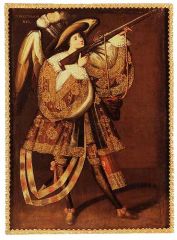
#90 Angel with Arquebus, Asiel Timor Dei Master of Calamarca (Le Paz School) 17th Century C.E. ___________________ Content: This shows an angel dressed in the royal attire of the Spanish Royalty (with a large hat and more South American feather adorning it), wearing Roman military boots, and holding aloft a muzzle firearm called an arquebus. ___________________ Style: Besides having the influences from its Bolivian artist, this fresco painting was done by the Le Paz school (an artistic school in Bolivia that always produced a certain style). The painting itself shows painting techniques from both Europe (Spain) and the indigenous cultures in South America (Bolivia). |
Context: This was an early representation of the colonization of the Americas and the exchange of good, influence, people, and ideas that thrived between Europe and the New World. It also happened that this fresco was done in a Spanish (Catholic) church by a Bolivian artist. Bolivia, at that time, was flourishing with economic wealth and quickly becoming the international intersecting point between Spain and South America. The angel itself was a common subject, Europeans called them "endogenous" angels. Both the incorporation of the angel's Spanish attire, Roman military boots, and musket served as imagery to illustrate the direct correlation to the Spanish and their ways of settling new lands under the flags of the Catholic religion and military conquest (conquistadors). |
|
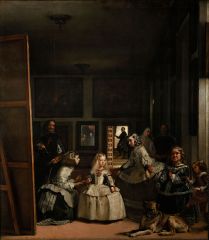
#91 Las Meninas Diego Velazquez 1656 C.E. _____________________ Content: This shows an intimate scene of the Spanish royalty within the artist's studio in the palace. The back of the canvas is visible, as well as the artist himself standing back to paint. The actual subjects (king and queen) are only shown in the reflection of a mirror on a wall. The other figures scattered around are a young royal princess, several attendants, and entertainment dwarves with a dog. ___________________ Style: The style is unorthodox in its perspective and failure in actually serving as a formal portrait. There is a definite use of darker tones and light, as well as detail and reflection. But the painting still manages to remain very much part of the Spanish Baroque style. |
Context: At this time, it was common for royal families to have their own artists to document their lives and provide formal portraits. This one, however, seems to serve the intentions of the artist rather than the royal patrons. Even though he was supposed to be painting the Spanish king Phillip the fourth and his queen, Velazquez ends up painting himself and the rest of the scene beside him. This was a way that Velazquez sought to elevate his own social status as an artist, by continuously portraying himself in royal artwork. |
|
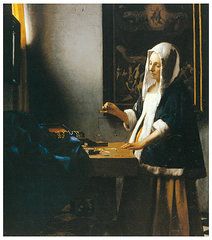
#92 Woman Holding a Balance Johannes Vermeer 1664 C.E. _____________________ Content: Although there are many smaller, symbolic images put into this painting, the main image is that of a women standing near a box of fine trinkets, holding a perfectly equalized balance. ___________________ Style: The painting is very Northern and very realistic, with features of light and one point perspective. The lines are also soft and almost muddled. The color too, is soft but still vibrant and well blended. Vermeer also developed a style of always placing a single light source in the upper, left corners of his paintings. |
Context: Johannes Vermeer was a Catholic convert in a highly Protestant Europe and had a strong will in his religion. As far as art, he mostly painted for himself and tended to gravitate towards intimate scenes of common Dutch life. Besides being an artist, Vermeer was also a working inn keeper who interacted on a daily basis with the common people. The many symbols that Vermeer tending to lay out in his paintings were ways on communicating how to live a better life. In this painting, many things serve as moral indicators. First of all, both the valuable objects laid out (that the women is not preoccupied with), the mirror (that the women in not obsessing over), and the religious painting in the back (actually one of Michelangelo's wall frescos about the Last Judgement), along with the empty, yet perfectly balanced scale the women is looking at all serve to communicate how a life can only be balanced if one does not indulge too much in wealth (valuables), vanity (mirror), or religious preoccupation with the afterlife (the painting). To paint this, Vermeer used a technique called "camera obscura". The process involved staging a scene and the use of mirrors to project that images onto a 2-D surface where it could be copied and painted. This resulted in the fuzzy lines of this painting. Vermeer was also a master of color, using mirco sized mixing of opposite colors that would blend on the larger scale of the painting. |
|

#93 The Palace at Versailles Versailles, France Louis Le Vau and Jules Hardouin - Mansart (architects) Begun: 1669 C.E. ___________________ Content: The complex of Versailles included the palace (with all three major roads leading to King's bedroom and courtyard), formal gardens, maintained woodland areas, and a city complex around where the workers would live. ___________________ Style: Everything about the construction of Versailles was to communicate the absolute power of the French monarchy. It was planning in four sections (listed above), with almost everything congerving at the palace. |
Context: Versailles was initially a royal hunting lodge that Louis the fourteenth renovated and expanded so that it could serve as the central palace of the French royalty. To complete the complex, architects, designers, gardeners, and others worked together to cohesively put the palace together. |
|
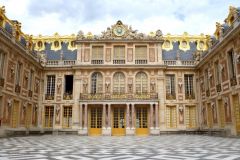
#93 Courtyard At the Palace of Versailles _____________________ Content: This is the courtyard near the main entrance that used to be nearest to the king's bedchambers. It's made of the same red and blue material as is the rest of the palace, with a patterned floor and gilded gold decoration. __________________ Style: The doors and windows in this area are reffered to as "Parisian" as they are common in France and Paris. They are tall and narrow, topped with a roman arch and used for incorporating natural light. There is also a decorative clock among the ornaments placed along the top of the building. |
Context: The context of the courtyard is similar to that of the whole palace, with an emphasis on perfect control and lavish, royal decoration. The clock that tops the courtyard, however, is though to have been stopped at the exact moment when Louis XIV died. |
|
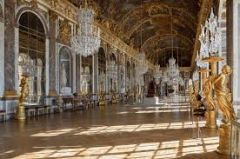
#93 Hall of Mirrors In the Palace of Versailles _____________________ Content: This is a long hallway lined with mirrors, statues, gilded gold, ceiling frescos and paintings, and chandeliers hanging from the ceiling. ___________________ Style: The hallway is a barrel vaulted space with the mirror implemented on one side to break up the "tunneling" feeling of the hall and also reflect more light from the windows opposite (mostly to reflect off the crystals). All the designing in lavish and Baroque. |
Context: Again, the interior decoration of this hall is one of the most extravagant examples of the royal spending in France and their ways of communicating superiority. |
|
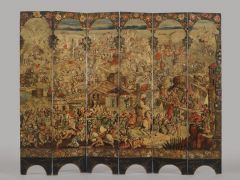
#94 Screen with the Siege of Belgrade and hunting scene (shown) Circle of the Gonzalez Family 1697 - 1701 C.E. ___________________ Content: Either side of this screen is painted with complicated scenes. The front shows a war scene (the battle between Spain and the Ottoman Empire) while the back shows a mellower hunting scene. ___________________ Style: The borders and design of both the paintings were inspired by Japanese styled art. The design of the war scene was copied from a print made in France, showing Baroque influence still. There are also Mother of Peal inlays (using the technique of Enconchado) for decoration. There are also European designs like the golden scrolls and ribbons that are put in as decorative additives. |
Context: This is a very multicultural piece, made in a time when Spain controlled the Philippines - the middle point between Japan and Europe. It represents the interaction of nations at the time of colonization in Spain and how it affected the art. In this piece alone, there are Japanese, Spanish, and French influences on the painting and development of the scenes. The piece was used as a room divider and usually had the men and women of the court sitting on either side. The men would be placed on the war scene side and the women would sit near the hunting/garden sides. It was a way to incorporate a Japanese-created furniture piece into both the feminine and masculine aspects of Spanish court. |
|
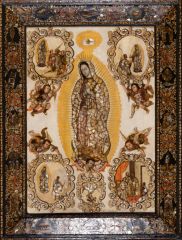
#95 The Virgin of Guadalupe (Virgen de Guadalupe) Based on the original Virgin of Guadalupe in the Basilica of Guadalupe, Mexico City - 16 century C.E. Miguel Gonzalez 1698 C.E. ___________________ Content: Based off of a famous fresco in Mexico, this small, framed piece shows the Virgin May in a shroud, surrounded by angels and misc. decoration. ___________________ Style: One of the most interesting techniques used in this piece was the enconchada way on inlaying Mother of Pearl and the use of natural resources to effect an image. The effect produced an intentional play with light, creating shimmer and drawing attention. Most of the figural subjects of the work are also outlined in black to help create contrast so that they better stood out from the other decoration. The black line also created illusionary depth in the piece in the sense that it looks like parts are coming off the canvas. |
Context: The artist of this piece was part of a family who, at this time, had mastered the creation of this type of art. Carrying on the legacy, Miguel Gonzalez utilized the Asian-inspired technique of enconchado to create more attention-drawing light to his work. This happened because Mexico, where this was made, was also a central point between Spain and Japan. The subject matter, as well, started to become of cultural importance to the citizens of Mexico. Here, the Virgin Mary is shown floating on top of the Eagle, which was part of the Mexican coat of arms. Basically, the depiction of this specific "Virgin of Guadalupe" becomes an artistic expression of culture in Mexico, starting with the interpritation of this piece. |
|
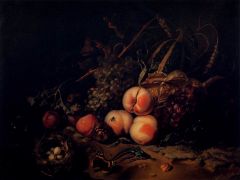
#96 Fruits and Insects Rachel Ruysch 1711 C.E. _____________________ Content: This is a still life showing "fruits and insects" spread out on a table (possibly in a basket) in darker lighting. ___________________ Style: As was common at the time, this painting has a dark background, organic shapes, pops of color, and specific uses of light. There is also a huge attention to detail and realism in both proportion and appearance. |
Context: Rachel, a successful female painter for well over 60 years, painted this still life amid the rise of science, logic, and understanding during the Enlightenment period. She lived in the Netherlands, where still lives were popular and the Northern techniques and mediums of oil on canvas were readily available. Growing up, Rachel's dad was a scientist and her mother was an artist. The blend of her parents resulted in her advancements in art, but also in close, scientific observation and realism that was exploding in other fields at that time as well. |
|
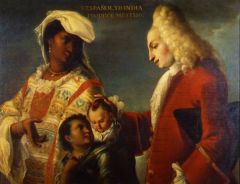
#97 Spaniard and Indian Produce a Mestizo Attributed to Juan Rodriguez Juarez 1715 C.E. _____________________ Content: This shows, as the title tells, a family with a Spanish European father, an Indian mother, and two children called "Mestizos". ___________________ Style: The paintings were done is a very straightforward way, possibly made with live models. Some, like this one, are labeled at the top, showing that they were more used for documentation that artistic expression. |
Context: These paintings were usually made in a series depicting the generations of families who had interracial marriages and how their offspring changes, The series would be considered "cast" paintings because, as well as following the potential biological understandings of family genetics, the paintings also had a social motive. At this time, Native people of the New World were considered the lower social class, with the pure-blood Spaniards being the highest class. The paintings, through their studies of changing races and social standings, sent the message to the early colonies in Meso-America and to the Spanish royalty, that interracial mixing resulted in less sophisticated families. |
|

#98 The Tête à Tête, from Marriage a la Mode William Hogarth 1743 C.E. _____________________ Content: this painting is of several people in a slightly trashed house in different stages of exhaustion. There is a man asleep on a chair, another walking off with an irritated look on his face, and a women is a still elevated position, sitting in the other chair. ___________________ Style: The style of this painting is the French Rococo. |
Context: The painting, and the series it came from, were meant to be a satire on the rising wealth of the middle class. In this painting, the artists are trying to show the naïvety in which these people in the middle class dealt with their new wealth. This picture seems to show three middle class people spending and indulging in parties and such, instead of investing their money or doing something more practical. |

